Discoteuthis laciniosa
Richard E. YoungIntroduction
D. laciniosa is most easily separated from its congener by the arrangement of photophores. Virtually nothing is known of its biology.
Diagnosis
A Discoteuthis ...
- with V-shaped groove in funnel locking-apparatus.
- with pair of photophores near the anteroventral margin of mantle.
Characteristics
- Arms
- Large arm III suckers with 10-12 low, scalloped teeth on distal margin.
- Tentacles
- Dorsal series of suckers absent on distal half of club dactylus (i.e., suckers in three series near tip of club).
- Medial suckers on manus of club flat relative to D. discus (inner ring height ca 35% of diameter compared to 60% of diameter).
- Largest club suckers with numerous (50-60) minute, irregular, low, scalloped teeth around entire inner ring.
 Click on an image to view larger version & data in a new window
Click on an image to view larger version & data in a new window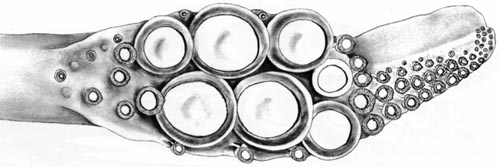
Figure. Oral view of tentacular club of D. laciniosa, 56 mm ML, paratype. Drawings from Young and Roper (1969).

Figure. Oral view of a badly damaged tentacular club of D. laciniosa, 72 mm ML, preserved. Photograph by R. Young.
 Click on an image to view larger version & data in a new window
Click on an image to view larger version & data in a new window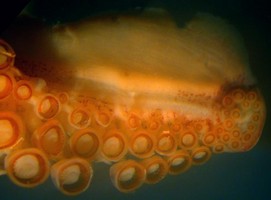
Figure. Oral view of the dactylus of the club of D. laciniosa, 72 mm ML, preserved. Photograph by R. Young.
 Click on an image to view larger version & data in a new window
Click on an image to view larger version & data in a new window
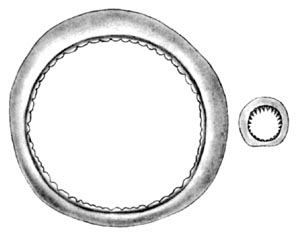
Figure. Side views of large manus suckers from D. discus (45 mm ML) and D. laciniosa (56 mm ML, paratype). Right - Oral views of a large sucker from manus and a much smaller sucker from the dactylus of D. laciniosa, 56 mm ML, paratype, showing dentition. Drawings from Young and Roper (1969).
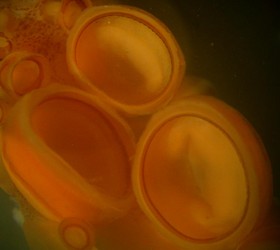
Figure. Oral view of large club suckeres of D. laciniosa, 72 mm ML, preserved. Photograph by R. Young.
- Head
- Beaks: Descriptions can be found here: Lower beak; upper beak.
- Beaks: Descriptions can be found here: Lower beak; upper beak.
- Funnel
- Funnel locking-apparatus with V-shaped groove.
- Mantle
- Flaplike papillae on free anterior margin of mantle (see drawing on below).
- Photophores
- Small organ on membrane connecting arms III and IV.
- One small pair on ventral margin of mantle.
- Gladius
- Conus present.
Life History
The smallest known specimen is a paralarva of 5mm ML (drawing). The paralarva is easily recognized by the wide separation of the fins due to the broad gladius, and by the mantle flaps. By 14 mm ML the fins virtually equal the mantle length. Mature squid are unknown.

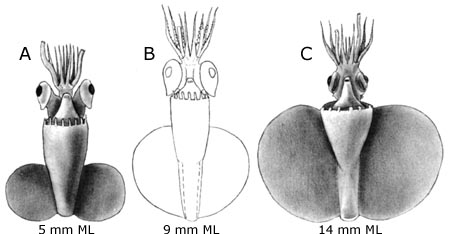
Figure. Ventral views of presumably young D. laciniosa. A - 24°37'N, 17°27'W, 200 m depth. B - ?. C - Same locality, 100 m depth. Drawings from Young and Roper (1969).
Comments
Young and Roper (1969) were doubtful that the 5 and 9 mm ML specimens belonged to the same species. Nesis (1982/87) indicates that the mantle flaps/papillae are developed only in juveniles. Apparently the young he had seen, in contrast to the above illustrations, lacked the flaps. This suggests that there may be a variety of species that are close to D. laciniosa.
Distribution
Vertical distribution
The little vertical distribution data available suggests that in Hawaiian waters D. laciniosa occupies mesopelagic depths during the day and migrates into epipelagic waters at night.

Figure. Chart showing the vertical distribution of D. laciniosa in Hawaiian waters. Captures were made with both open and opening/closing trawls. Yellow bars - Fishing depth-range of opening/closing trawl. Yellow-filled circles - Modal fishing depth, day capture. Blue-filled square - Midpoint of oblique tow, night capture. Blue bar - Depth range of oblique tow. Drawing modified from Young (1978).
Geographical distribution
The type locality is about 40 miles NNE of Bermuda. D. laciniosa occurs throughout the tropical and subtropical Atlantic, Indian and Pacific Oceans (Nesis, 1982/87).
References
Nesis, K. N. 1982/87. Abridged key to the cephalopod mollusks of the world's ocean. 385+ii pp. Light and Food Industry Publishing House, Moscow. (In Russian.). Translated into English by B. S. Levitov, ed. by L. A. Burgess (1987), Cephalopods of the world. T. F. H. Publications, Neptune City, NJ, 351pp.
Young, R. E. and C. F. E. Roper. 1969. A monograph of the Cephalopoda of the North Atlantic: The family Cycloteuthidae. Smithsonian Contributions to Zoology No. 5:1-24.
Young, R. E. 1978. Vertical distribution and photosensitive vesicles of pelagic cephalopods from Hawaiian waters. Fish. Bull., 76: 583-615.
About This Page

University of Hawaii, Honolulu, HI, USA
Page copyright © 1996
 Page: Tree of Life
Discoteuthis laciniosa .
Authored by
Richard E. Young.
The TEXT of this page is licensed under the
Creative Commons Attribution-NonCommercial License - Version 3.0. Note that images and other media
featured on this page are each governed by their own license, and they may or may not be available
for reuse. Click on an image or a media link to access the media data window, which provides the
relevant licensing information. For the general terms and conditions of ToL material reuse and
redistribution, please see the Tree of Life Copyright
Policies.
Page: Tree of Life
Discoteuthis laciniosa .
Authored by
Richard E. Young.
The TEXT of this page is licensed under the
Creative Commons Attribution-NonCommercial License - Version 3.0. Note that images and other media
featured on this page are each governed by their own license, and they may or may not be available
for reuse. Click on an image or a media link to access the media data window, which provides the
relevant licensing information. For the general terms and conditions of ToL material reuse and
redistribution, please see the Tree of Life Copyright
Policies.
- Content changed 26 March 2019
Citing this page:
Young, Richard E. 2019. Discoteuthis laciniosa . Version 26 March 2019 (under construction). http://tolweb.org/Discoteuthis_laciniosa/19626/2019.03.26 in The Tree of Life Web Project, http://tolweb.org/




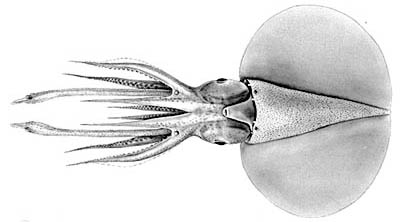


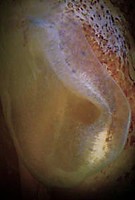
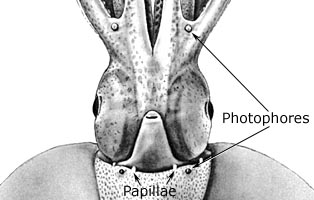
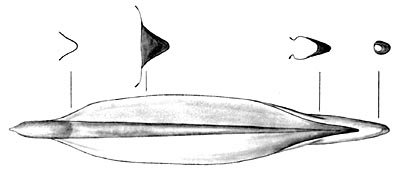



 Go to quick links
Go to quick search
Go to navigation for this section of the ToL site
Go to detailed links for the ToL site
Go to quick links
Go to quick search
Go to navigation for this section of the ToL site
Go to detailed links for the ToL site